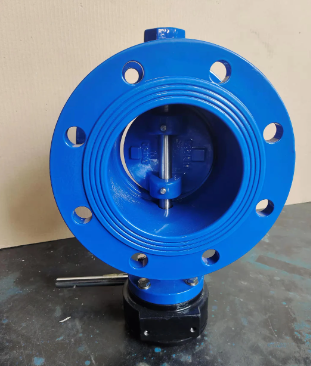Butterfly valves offer several advantages compared to other types of valves, making them a popular choice in various industries and applications.
Here are some of the advantages of using butterfly valves:
Cost-Effective: Butterfly valves are generally more cost-effective compared to other valve types, such as gate valves or ball valves. They typically have a simpler design and require fewer materials, resulting in lower manufacturing and installation costs.
Compact and Lightweight: Butterfly valves are compact and lightweight, which makes them easier to install and requires less space compared to bulkier valves. Their compact size also means they have a lower pressure drop, resulting in energy savings.
Quick Operation: Butterfly valves can be quickly and easily operated. They have a simple quarter-turn mechanism, allowing for fast opening and closing. This quick operation is advantageous in applications where swift control of fluid flow is required.
Good Flow Control: Butterfly valves offer good flow control capabilities, especially in applications that involve large flow rates. They have a straight-through flow path when fully open, minimizing flow restrictions and pressure drops.
Wide Range of Sizes: Butterfly valves are available in a wide range of sizes, from small diameters to large ones, making them suitable for various piping systems and applications.
Versatility: Butterfly valves are versatile and can handle a wide variety of fluids, including liquids, gases, and slurries. They are suitable for use in industries such as water treatment, HVAC, chemical processing, and food and beverage.
Low Maintenance: Butterfly valves have fewer moving parts compared to other types of valves, which reduces the need for frequent maintenance and lowers the risk of mechanical failure. This results in reduced downtime and cost savings.
Bi-Directional Sealing: Most butterfly valves offer bi-directional sealing, meaning they can effectively seal in both flow directions. This feature eliminates the need for specific installation orientations, enhancing ease of installation.
Resistant to Contaminants: The design of butterfly valves, with their disc located away from the flow path when fully open, makes them less prone to buildup of contaminants or debris. This reduces the risk of clogging and ensures reliable operation.
Lower Torque Requirement: Butterfly valves typically require lower operating torque compared to other valve types. This allows for the use of smaller, more economical actuators, resulting in cost savings.
It’s important to note that the suitability of a butterfly valve depends on the specific application requirements. Other valve types may be more appropriate in certain situations, such as when precise flow control or high-pressure applications are involved. Consulting with valve manufacturers or industry experts can help determine the most suitable valve type for a particular application.
What are the different types of butterfly valves available?
There are several different types of butterfly valves available, each with its own design and characteristics.
The main types of butterfly valves include:
Concentric Butterfly Valve: This is the most common type of butterfly valve. It features a disc that is centered in the valve body and supported by a shaft passing through the center of the disc. The disc sealing surface is concentric with the valve bore, providing a bubble-tight shut-off. Concentric butterfly valves are typically used in a wide range of applications and offer good flow control.
Double Offset Butterfly Valve: The double offset butterfly valve has a disc that is offset from the centerline of the valve body and shaft. This design allows for improved sealing capabilities and reduced operating torque. The sealing surface is generally inclined or conical, providing a tighter seal and better resistance to wear and high-pressure applications.
Triple Offset Butterfly Valve: The triple offset butterfly valve is a high-performance valve designed for applications that require tight shut-off and superior sealing performance. It has three offsets: the disc is offset from the centerline, the shaft is offset from the centerline, and the sealing surface is offset from the centerline of the disc. This design ensures a tight, bubble-tight seal and minimizes friction during operation.
Eccentric Butterfly Valve: The eccentric butterfly valve has a disc that is offset from the centerline of the valve body but maintains a centered shaft. This design allows for a tighter seal and reduces the chances of the disc rubbing against the seat during operation, improving the valve’s durability and performance.
High-Performance Butterfly Valve: High-performance butterfly valves are designed for demanding applications that require tight shut-off and high-pressure capabilities. They often incorporate features such as metal seats, special sealing materials, and advanced construction to ensure reliable performance under extreme conditions.
Lined Butterfly Valve: Lined butterfly valves have a corrosion-resistant lining applied to the valve body and disc. The lining material, such as PTFE or rubber, provides excellent chemical resistance, making these valves suitable for handling corrosive fluids or gases.
Wafer and Lug Butterfly Valve: Wafer and lug butterfly valves are designed for easy installation between flanges. Wafer-style valves are lightweight and fit between flanges using bolts or studs, while lug-style valves have threaded inserts or bolts that allow them to be installed between flanges without the need for nuts on both sides.
Flanged Butterfly Valve: Flanged butterfly valves have flanged ends for direct connection to the pipeline. They are commonly used in applications where a secure and leak-free connection is required.
It’s important to note that these are general categories, and there may be variations and combinations of these types available in the market. The selection of the appropriate type of butterfly valve depends on factors such as application requirements, operating conditions, pressure rating, and fluid characteristics. Consulting with valve manufacturers or industry experts can help in determining the most suitable type of butterfly valve for a specific application.

